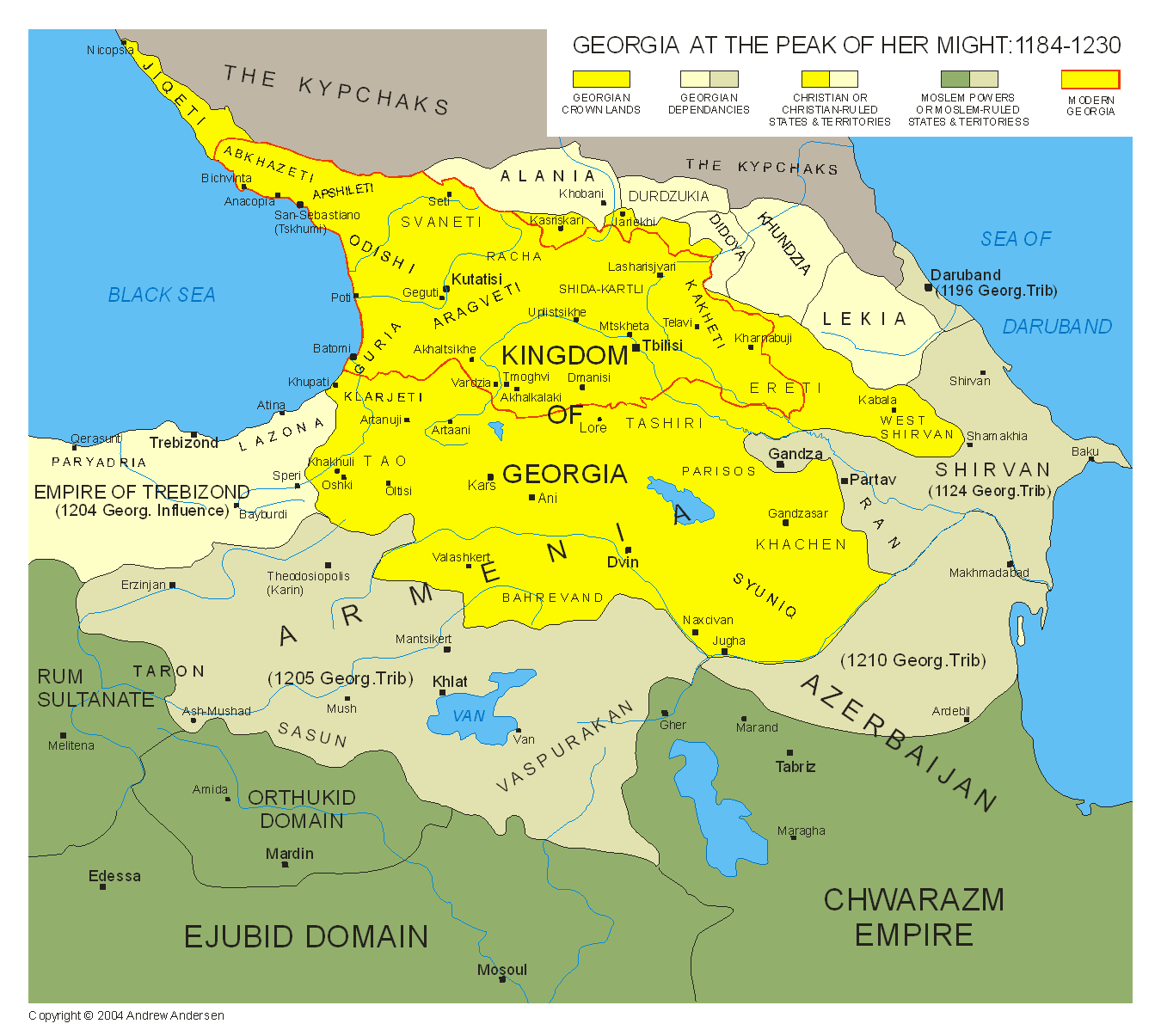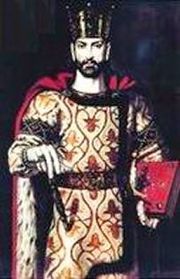
Kingdom of Georgia
Encyclopedia

It flourished during the 11th and 12th centuries, the so-called "golden age" of the history of Georgia
History of Georgia (country)
The nation of Georgia was first unified as a kingdom under the Bagrationi dynasty in the 9th to 10th century, arising from a number of predecessor states of ancient Colchis and Iberia...
. It fell to the Mongol invasions of the 13th century, but managed to re-assert sovereignty by 1327. But renewed Turco-Mongol
Turco-Mongol
Turko-Mongol is a modern designation for various nomads who were subjects of the Mongol Empire. Being progressively Turkicized in terms of language and identity following the Mongol conquests, they derived their ethnic and cultural origins from steppes of Central Asia...
incursions from 1386 led to the final collapse of the kingdom into anarchy by 1466.
Origins

Bagrationi Dynasty
The Bagrationi dynasty was the ruling family of Georgia. Their ascendency lasted from the early Middle Ages until the early 19th century. In modern usage, this royal line is frequently referred to as the Georgian Bagratids, a Hellenized form of their dynastic name.The origin of the Bagrationi...
can be traced to the 6th century. They ruled Tao-Klarjeti
Tao-Klarjeti
Tao-Klarjeti is the term conventionally used in modern history writing to describe the historic south-western Georgian principalities, now forming part of north-eastern Turkey and divided among the provinces of Erzurum, Artvin, Ardahan and Kars...
from the 9th century.
The unification of Georgia begins in AD 888, when Adarnase IV of Iberia
Adarnase IV of Iberia
Adarnase IV was a member of the Georgian Bagratid dynasty of Tao-Klarjeti and prince of Iberia/Kartli, responsible for the restoration of kingship, which had been in abeyance since it had been abolished by Iran in the sixth century, in 888....
took the title of "king of all Georgians".
The United Kingdom of Georgia was established in 978. In this year Bagrat III, son of Gurgen II, became the ruler of the Kingdom of Western Georgia (Kingdom of Abkhazeti), including the Principalities of Imereti
Imereti
Imereti is a province in Georgia situated along the middle and upper reaches of the Rioni river. It consists of the following Georgian administrative-territorial units:#Kutaisi #Baghdati region#Vani region#Zestafoni region...
, Samegrelo
Samegrelo
Samegrelo/Samargalo or Megrelia, Mingrelia is a historic province in the western part of Georgia, formerly also known as Odishi.It is inhabited by the Megrelians, an ethnic subgroup of the Georgians.-Geography and Climate:...
, Abkhazeti (Abkhazia
Abkhazia
Abkhazia is a disputed political entity on the eastern coast of the Black Sea and the south-western flank of the Caucasus.Abkhazia considers itself an independent state, called the Republic of Abkhazia or Apsny...
), Guria
Guria
Guria is a region in Georgia, in the western part of the country, bordered by the eastern end of the Black Sea. The region has a population of 143,357 and Ozurgeti is a regional capital.-Geography:...
and Svaneti
Svaneti
Svaneti is a historic province in Georgia, in the northwestern part of the country. It is inhabited by the Svans, a geographic subgroup of the Georgians.- Geography :...
. Bagrat's mother was Queen Gurandukht, a daughter of George II of Abkhazia
George II of Abkhazia
George II was King of the Abkhazians from 916 AD until 960 AD. His lengthy reign is regarded as a zenith of cultural flowering and political power of his realm....
.
Golden age
The unified monarchy maintained its precarious independence from the Byzantine and Seljuk empires throughout the 11th century, and flourished under David IV the BuilderDavid IV of Georgia
David IV "the Builder", also known as David II , of the Bagrationi dynasty, was a king of Georgia from 1089 until his death in 1125....
(1089–1125), who repelled the Seljuk attacks and essentially completed the unification of Georgia with the re-conquest of Tbilisi in 1122.
With the decline of Byzantine power and the dissolution of the Great Seljuk Empire, Georgia became one of the pre-eminent nations of the Christian
Eastern Christianity
Eastern Christianity comprises the Christian traditions and churches that developed in the Balkans, Eastern Europe, Asia Minor, the Middle East, Northeastern Africa, India and parts of the Far East over several centuries of religious antiquity. The term is generally used in Western Christianity to...
East
Middle East
The Middle East is a region that encompasses Western Asia and Northern Africa. It is often used as a synonym for Near East, in opposition to Far East...
, her pan-Caucasian empire stretching, at its largest extent, from North Caucasus
North Caucasus
The North Caucasus is the northern part of the Caucasus region between the Black and Caspian Seas and within European Russia. The term is also used as a synonym for the North Caucasus economic region of Russia....
to northern Iran
Iran
Iran , officially the Islamic Republic of Iran , is a country in Southern and Western Asia. The name "Iran" has been in use natively since the Sassanian era and came into use internationally in 1935, before which the country was known to the Western world as Persia...
, and eastwards into Asia Minor
Asia Minor
Asia Minor is a geographical location at the westernmost protrusion of Asia, also called Anatolia, and corresponds to the western two thirds of the Asian part of Turkey...
.
In spite of repeated incidents of dynastic strife, the kingdom continued to prosper during the reigns of Demetrios I (1125–1156), George III
George III of Georgia
Giorgi III , of the Bagrationi dynasty, was king of Georgia from 1156 to 1184. His reign, and that of Tamar, are seen as the 'golden age' of Georgian history, the era of empire, diplomatic success, military triumphs, great learning, cultural, spiritual, and artistic flowering.-Life:He succeeded on...
(1156–1184), and especially, his daughter Tamar
Tamar of Georgia
Tamar , of the Bagrationi dynasty, was Queen Regnant of Georgia from 1184 to 1213. Tamar presided over the "Golden age" of the medieval Georgian monarchy...
(1184–1213).
With the death of George III the main male line
Patrilineality
Patrilineality is a system in which one belongs to one's father's lineage. It generally involves the inheritance of property, names or titles through the male line as well....
went extinct and the dynasty was continued by the marriage of Queen Tamar with the Alan
Alans
The Alans, or the Alani, occasionally termed Alauni or Halani, were a group of Sarmatian tribes, nomadic pastoralists of the 1st millennium AD who spoke an Eastern Iranian language which derived from Scytho-Sarmatian and which in turn evolved into modern Ossetian.-Name:The various forms of Alan —...
prince David Soslan
David Soslan
David Soslan was an Alan prince and a King Consort of Georgia as the second husband of Queen Regnant Tamar who married him c. 1189. He is chiefly known for his military exploits during Georgia’s wars against its Muslim neighbors.- Origins :...
of reputed Bagratid descent.
Mongol rule
The invasions by the Khwarezmians in 1225 and the MongolsMongol Empire
The Mongol Empire , initially named as Greater Mongol State was a great empire during the 13th and 14th centuries...
in 1236 terminated Georgia’s "golden age". The struggle against the Mongol rule
Mongol invasions of Georgia
The Mongol invasions reached the kingdom of Georgia and the Armenian Kingdom of Cilicia in 1234, forcing Georgia into submission by 1238....
created a diarchy
Diarchy
Diarchy , from the Greek δι- "twice" and αρχια, "rule", is a form of government in which two individuals, the diarchs, are the heads of state. In most diarchies, the diarchs hold their position for life and pass the responsibilities and power of the position to their children or family when they...
, with an ambitious lateral branch of the Bagrationi dynasty holding sway over Imereti
Kingdom of Imereti
The Kingdom of Imereti was established in 1455 by a member of the house of Bagration when the Kingdom of Georgia was dissolved into rival kingdoms. Before that time, Imereti was considered a separate kingdom within the Kingdom of Georgia, to which a cadet branch of the Bagration royal family held...
, western Georgia.
Final disintegration

George V of Georgia
George V, the "Brilliant" was King of Georgia from 1299 to 1302 and again from 1314 until his death. A flexible and far-sighted politician, he recovered Georgia from a century-long Mongol domination, restoring the country’s previous strength and Christian culture.-Reign:George was born to King...
(1299–1302, 1314–1346), but the eight onslaughts of the Turco-Mongol
Turco-Mongol
Turko-Mongol is a modern designation for various nomads who were subjects of the Mongol Empire. Being progressively Turkicized in terms of language and identity following the Mongol conquests, they derived their ethnic and cultural origins from steppes of Central Asia...
conqueror Timur
Timur
Timur , historically known as Tamerlane in English , was a 14th-century conqueror of West, South and Central Asia, and the founder of the Timurid dynasty in Central Asia, and great-great-grandfather of Babur, the founder of the Mughal Dynasty, which survived as the Mughal Empire in India until...
between 1386 and 1403 dealt a great blow to the Georgian kingdom. Its unity was finally shattered and, by 1490/91, the once powerful monarchy fragmentized into three independent kingdoms – Kartli
Kartli
Kartli is a historical region in central-to-eastern Georgia traversed by the river Mtkvari , on which Georgia's capital, Tbilisi, is situated. Known to the Classical authors as Iberia, Kartli played a crucial role in ethnic and political consolidation of the Georgians in the Middle Ages...
(central to eastern Georgia), Kakheti
Kakheti
Kakheti is a historical province in Eastern Georgia inhabited by Kakhetians who speak a local dialect of Georgian. It is bordered by the small mountainous province of Tusheti and the Greater Caucasus mountain range to the north, Russian Federation to the Northeast, Azerbaijan to the Southeast, and...
(eastern Georgia), and Imereti (western Georgia) – each led by the rival branches of the Bagrationi dynasty, and into five semi-independent principalities – Odishi, (Mingrelia), Guria
Guria
Guria is a region in Georgia, in the western part of the country, bordered by the eastern end of the Black Sea. The region has a population of 143,357 and Ozurgeti is a regional capital.-Geography:...
, Abkhazia
Principality of Abkhazia
The Principality of Abkhazia emerged as a separate feudal entity in the 15th-16th centuries, amid the civil wars in the Kingdom of Georgia that concluded with the dissolution of the unified Georgian monarchy...
, Svaneti
Svaneti
Svaneti is a historic province in Georgia, in the northwestern part of the country. It is inhabited by the Svans, a geographic subgroup of the Georgians.- Geography :...
, and Samtskhe – dominated by their own feudal clans.
See also
- Bagrationi dynastyBagrationi DynastyThe Bagrationi dynasty was the ruling family of Georgia. Their ascendency lasted from the early Middle Ages until the early 19th century. In modern usage, this royal line is frequently referred to as the Georgian Bagratids, a Hellenized form of their dynastic name.The origin of the Bagrationi...
- List of Bagrationi rulers of Georgia
- List of Georgian Kings
- Monarchism in GeorgiaMonarchism in GeorgiaThe former Soviet republic of Georgia has a monarchic tradition that traces its origins to the Hellenistic period. The medieval Kingdom of Georgia ruled by the Bagrationi dynasty has left behind a legacy that lasts in Georgia even in modern times...
- Line of succession to the Georgian throneLine of succession to the Georgian throneThe Georgian royal family of the Bagrations practiced masculine primogeniture, legitimate sons and their descendants taking precedence over daughters and natural sons, and their descendants...
- AtabegAtabegAtabeg, Atabek, or Atabey is a hereditary title of nobility of Turkic origin, indicating a governor of a nation or province who was subordinate to a monarch and charged with raising the crown prince...

